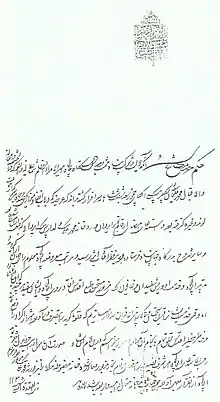Beglerbegi
Beglerbegi (Persian: بیگلربیگی) was a title generally held by governors of provinces of higher importance in Safavid Iran.[1][2]

The title is of Turkish origin, meaning "beg of begs" (commander of commanders).[1] Under the Safavids, it meant governor-general.[3]
The title first appears in 1543/44, when the Safavid ruler Tahmasp I (r. 1524–1576) issued a decree that referred the governor of Herat as beglerbegi.[1] The title was created to distinguish more important governors from less important ones.[4] As a result, starting in the 1540s, governor-general (beglerbegi), senior-governor (hakem-khan), and junior-governor (hakem-soltan) were one of the titles that would be given to a emir governing a province or smaller administration.[3]
Other beglerbegis soon appear in records, such as the beglerbegi of Astarabad in 1548, and the beglerbegi of Kerman in 1565. According to Willem Floor: "This, and the fact that beglerbegis also were at the same time emir al-omara of their jurisdiction, contradicts the view that the term beglerbegi was simply a Turkish translation of the title emir al-omara." Beglerbegi was only applied to governors of large administrations in the second half of the 16th-century. The title was more commonly employed in the latter part of the 17th century, even for lesser administrations. Several khans and soltans were subject to the beglerbegi.[3]
The beglerbegis had complete command over the soldiers and khans under their command. According to the early 18th-century Dastur al-Moluk, a beglerbegi was superior to a khan in rank, and the soltans were subordinate to the khan. The beglerbegi, who was also an emir, was also known as the emir al-omara of the province that he oversaw. There were eleven beglerbegis towards the end of the reign of Shah Abbas II (r. 1588–1629); five gholams (Fars, Karabakh, Baghdad, Astarabad, Shirvan), two valis of some sort (Lorestan and Kurdistan) and four Qizilbash emirs (Khorasan, Chokhur-e Sa'd (Erivan), Azerbaijan, Qandahar).[5]
Herat and Kerman, which were among the first provinces to be administered by a beglerbegi, are not included in the list. This is due to not all of these administrations would continue to be governed by a beglerbegi after the 1630s. After the Treaty of Zuhab in 1639, the Safavids lost Baghdad to the Ottoman Empire. Between 1632 and 1722, a vizier oversaw the administration of Fars.[5]
References
- Jackson 1989, p. 84.
- Floor 2001, pp. 95–96.
- Floor 2001, p. 96.
- Floor 2001, p. 95.
- Floor 2001, p. 97.
Sources
- Floor, Willem (2001). Safavid Government Institutions. Mazda Publishers. ISBN 978-1568591353.
- Jackson, Peter (1989). "Beglerbegī". In Yarshater, Ehsan (ed.). Encyclopædia Iranica, Volume IV/1: Bāyju–Behruz. London and New York: Routledge & Kegan Paul. p. 84. ISBN 978-0-71009-124-6.